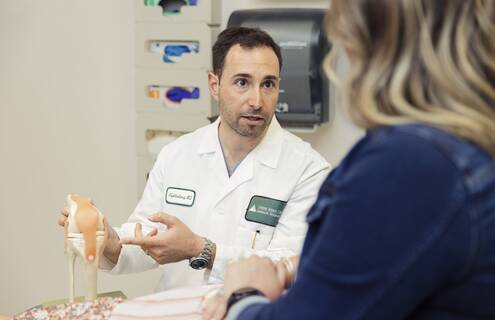
Return to sport after an ACL injury is not 100% guaranteed. We consider these injuries career-threatening, which is why prevention is vital.
Neal Goldenberg, MD, chair of Sports Medicine at CheshireWhile anyone who participates in sports can benefit from an ACL (anterior cruciate ligament) injury prevention program, those most at risk of tearing an ACL are young athletes ages 15 to 24 years old and those who play sports that include jumping, cutting, and pivoting motions. These injuries are especially common in active young women.
ACL tears are one of the most common and devastating knee injuries that affect both young people and adult “weekend warriors.”
ACL injuries are most common while playing sports such as:
- Soccer
- Football
- Basketball
- Skiing and snowboarding
But they can occur in any sport or athletic activity, even after a slip and fall injury.
“We’re seeing more and more ACL injuries,” says Neal Goldenberg, MD, chair of Sports Medicine at Cheshire Medical Center. “They can occur in anybody, and we see them in all age groups, but the highest risk age group is 14 to 25 years old because they tend to be more active. And ACL injuries are 2 to 6 times more common in females than males.”
If you have already sustained this injury in one knee, you’re at a higher risk of tearing it again in the other knee and at higher risk for developing arthritis.
Surgery is usually the best form of treatment, and full recovery takes about 9 to 15 months. Learn more from Goldenberg in ACL tears: Symptoms, surgery, and recovery.
“We consider these injuries not career-ending but career-threatening, which is why prevention is vital,” he says.
What causes injuries to the ACL?
The ACL is located in the center of the knee, helping to stabilize the knee joint during cutting and pivoting movements.
Most ACL injuries are non-contact, twisting injuries that occur when the athlete goes to change directions suddenly and their knee gives way.
“What happens is the tibia, or the shin bone, moves forward in relation to the femur, tearing the ACL,” says Goldenberg. “Often, this happens when the knee is no longer directly above the toes. So, if you think about the position of someone cutting, and they're more kind of ‘knock-kneed’ at that time, they’re at higher risk for an ACL injury.”
The most common movements that cause this injury are:
- Cutting
- Deceleration
- Landing
- Landing straight-legged
- Pivoting
especially when these movements are done with improper form.
Prevention programs for ACL injuries
By working on strength, balance, plyometrics, and body awareness (proprioception), people can guard against possible ACL tears.
These prevention programs typically incorporate exercises that promote proper form while landing, decelerating, and changing directions—aligning your knees over your toes during the movements listed above.
Often, it is helpful to do these with a partner so you can help each other achieve proper form with the knees over the toes, which is important in preventing ACL injuries.
“It doesn’t need to be a very long or intensive routine,” Goldenberg says. “The whole point of a prevention program is that it's easy for anybody to do. Typically, the program doesn't need to last more than 20 minutes and only needs to be done 2 to 3 times a week.”
“Cheshire’s athletic trainers at the local high schools can implement these plans for coaches. Parents, student-athletes, or active people at risk of ACL tears can also find and perform a good preventative routine on their own.”
Goldenberg recommends the following online resources
- FIFA 11+ program’s detailed prevention plans
- How to prevent ACL Injuries from acltear.info
If you want Cheshire Medical Center’s Orthopaedics department and athletic trainers to help create an injury prevention program for yourself or your team, please call Sports Medicine at 603-354-5454 ext. 3730 or talk to your primary care provider.